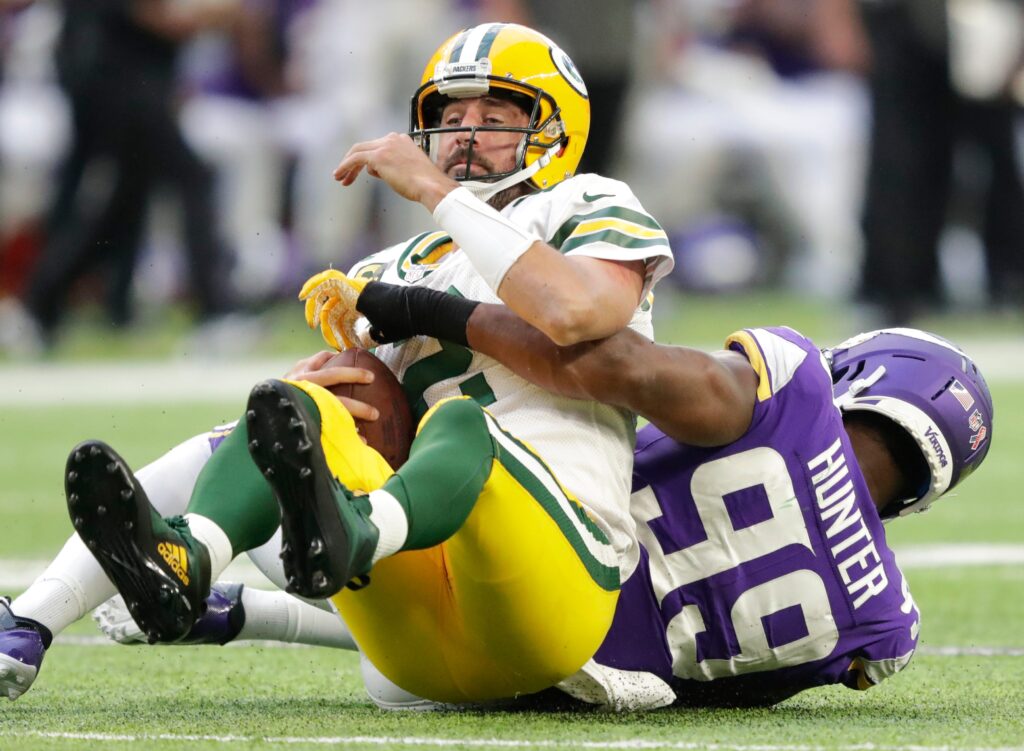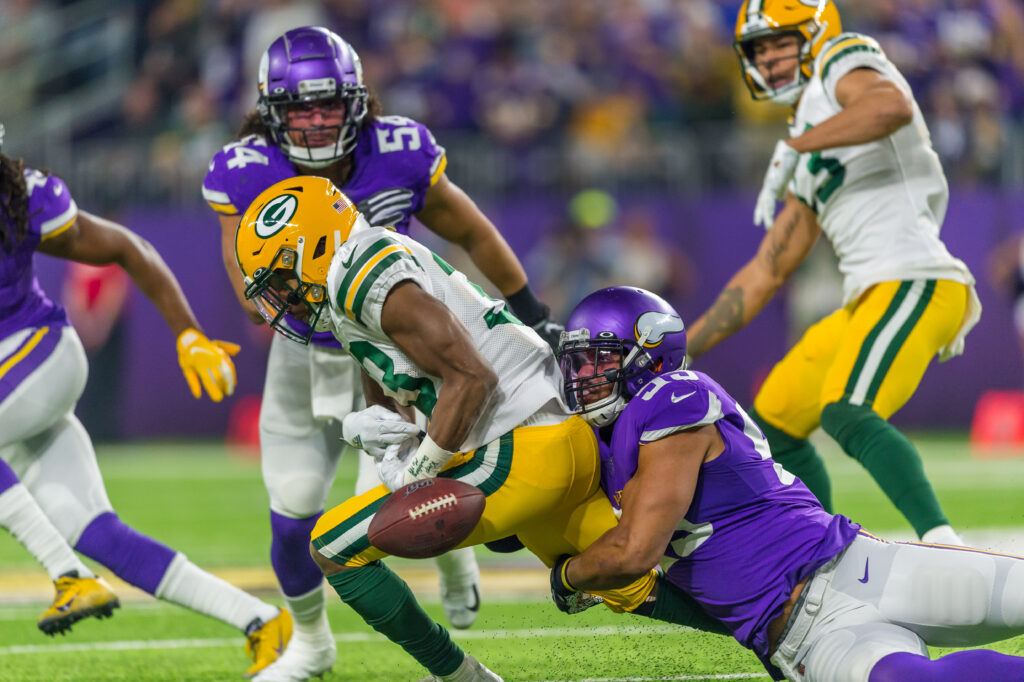When the baseball analytics Moneyball boom was taking place, a key concept that was championed by the early adopters was the idea that small sample sizes can be misleading. They found that players would routinely have stretches — sometimes lasting full seasons — where they either succeeded or struggled based on good/bad luck, which led to reactionary decisions by managers or front offices.
Now think about the sample sizes we’re talking about when it comes to baseball. A healthy single season could be 600-plus at-bats or 150 innings pitched and we still might not have the real truth. Compare that to football, where judgements have to be made on the basis of 60-70 plays after the first week of the season. Teams quickly have to figure out what was legit and what was fool’s gold in order to make adjustments going forward.
That’s the challenge for the Minnesota Vikings as they head into Week 2 coming off a 23-7 beatdown of the Green Bay Packers in which nearly everything went their way.
Kevin O’Connell strikes you as a coach who would understand the concept of regression. After all, he was 18 years old when Michael Lewis released Moneyball. The Vikings’ new head coach said on Monday that staving off regression means looking closely at the areas of Sunday’s game that could still be improved and focusing on those points during the leadup to Vikings-Eagles on Monday Night FOotball.
“Even some of the things that were successful, I look at it in a way where I still see where we could be better,” O’Connell said. “I still see offensively where there were some missed opportunities. We left some yards out there. For sure, left some points out there. Now I see where I can be better as a play-caller. How am I communicating? How am I making sure that our personnel is deployed in the best possible way? Our tempos, our variations of how we want to align, I’m constantly looking at those things and really looking inward, first and foremost.”
Putting focus on the areas that team will need to repeat and where they’ll have to improve to beat the Eagles and carry on success throughout the schedule is the along the lines of the “process over results” mantra. Of course, results are all that matters in the standings, so maybe it’s better phrased, “process over immediate results,” because immediate results can lie.
It isn’t that hard to spot the razor’s edge in which a 23-7 game could have ended up being much, much closer in the end. If Aaron Rodgers’ pass to Christian Watson is caught for a 75-yard touchdown or if the Packers punch it in from the 1-yard line or if the Vikings don’t convert a late-game third down that led to a dagger field goal or if Kirk Cousins is strip-sacked rather than barely escaping and finding Justin Jefferson for a 64-yard pass, things could have looked different.
O’Connell is going to use both the sustainable and unsustainable things as teaching tools for his players.
“I’m able to stand in front of the guys really kind of coach them hard knowing that these are the spots and give them real examples, tangible evidence of things we did really well and things we could have been better at,” O’Connell said.
How do they do they make sure they are covering the right stuff and weeding out biases that are related to the immediate results? By not moving the goal posts.
“Coach Wes [Phillips], talking to the offense [said] how we’re going to evaluate this film — whether we win or lose, we’re going to evaluate it the same way,” receiver Adam Thielen said. “Because whether you win or lose, there’s going to be things you’ve got to correct.”
So which parts of the Vikings’ drubbing of the Packers should they be looking to carry over and which might need correction in order to avoid regression?
The easiest place to start is with pressure on Kirk Cousins. Per PFF, the Packers pressured Cousins on 42.4% of his dropbacks and the veteran QB posted an extremely impressive 10.5 yards per pass attempt — a number largely driven by the 64-yard completion. Last year Cousins was pressured on 33.7% of throws and gained just 5.1 yards per attempt. The highest mark of his career under duress is 6.8 (2015 and 2018), meaning that the Vikings need to protect him better or there will be problems in the long run.
The pressure particularly came from the middle, where right guard Ed Ingram allowed five pressures and center Garrett Bradbury gave up four. Pass rush over the center might be a difficult issue to resolve at this stage but O’Connell is looking for his rookie guard to learn from the experience of facing off with a quality Packers pass rush.
“I thought he battled,” O’Connell said of Ingram. “I thought he was physical on the run game and every snap is new at this level for Ed [Ingram], so he’s learning, he’s adding tools to his toolbox on a play-to-play basis. I thought he really ascended as the game went on, and then ultimately, there’s a lot to correct, clean up – technique, fundamentals.”
There were good signs along the offensive line that are likely to carry over, namely Christian Darrisaw. The 2021 first-round pick, who had a noticeably strong training camp, gave up zero pressures in “true pass set” situations where the O-line was not assisted by play-action or screens. Likewise left guard Ezra Cleveland posted a clean slate against the toughest rushes. He has improved in each of his first two seasons and is aiming to solidify himself as a key part of the line this year. Week 1 appears to be a step in that direction.
Through the air, Cousins completed 23 of 32 passes at 8.7 yards per attempt. When throwing to Justin Jefferson he hit nine passes for 184 yards. When targeting anyone not named Jefferson, he completed 14 passes at 4.2 yards per attempt.
Not that it takes much explanation of why those numbers aren’t sustainable but consider this: Jefferson made up 66% of the total passing yards on Sunday. Last year Cooper Kupp had an historic season and made up 39.8% of Los Angeles’s total passing attack.
Also zero of Jefferson’s targets were into the coverage of star corner Jaire Alexander. The Vikings simply can’t expect the opponent’s best player to be nowhere near Jefferson for the rest of the year.
One of the places the football may go in the future is in the direction of tight end Irv Smith Jr., who did not catch a pass on two targets and only played 19 snaps. He was coming back from thumb surgery that kept him out of the majority of training camp. As he continues to ramp up we should expect more opportunities for Cousins to get him the ball.
“Irv’s gonna have a major role for us,” O’Connell said. “Even on some plays that maybe Justin was targeted or Adam was targeted yesterday, Irv’s out there as a featured part of the play… and he will continue to show up throughout the season. I’ve got so much confidence in him and excited about his continued growth.”
On the defensive side the Vikings gave up 6.2 yards per carry, which wasn’t a big concern considering the struggles of Green Bay’s passing game but could crop up down the road. And while it felt like Rodgers was under duress for most of the day, some of that was self inflicted and PFF’s data only counted 11 drop backs of 38 in which Rodgers was pressured (28.9%). Rodgers was stunningly poor when pressured, completing just two passes for 15 yards.
“The longer we play our defense, the more film you’re going to see, the longer you can break it down, anticipate it better,” defensive tackle Harrison Phillips said. “I feel like me personally and a lot of other players that play say you’re better as the season goes on. You have more reps to see this is a run play or a pass play based on this, this key I’m getting. You can kind of anticipate plays a little better.”
So as the Vikings get an extra day to prepare for the Eagles, they have plenty to be pleased about and a few things to shore up on both sides of the ball in order to repeat their performance. And it appears the team fully understands which parts can be sustained week to week and which cannot.










